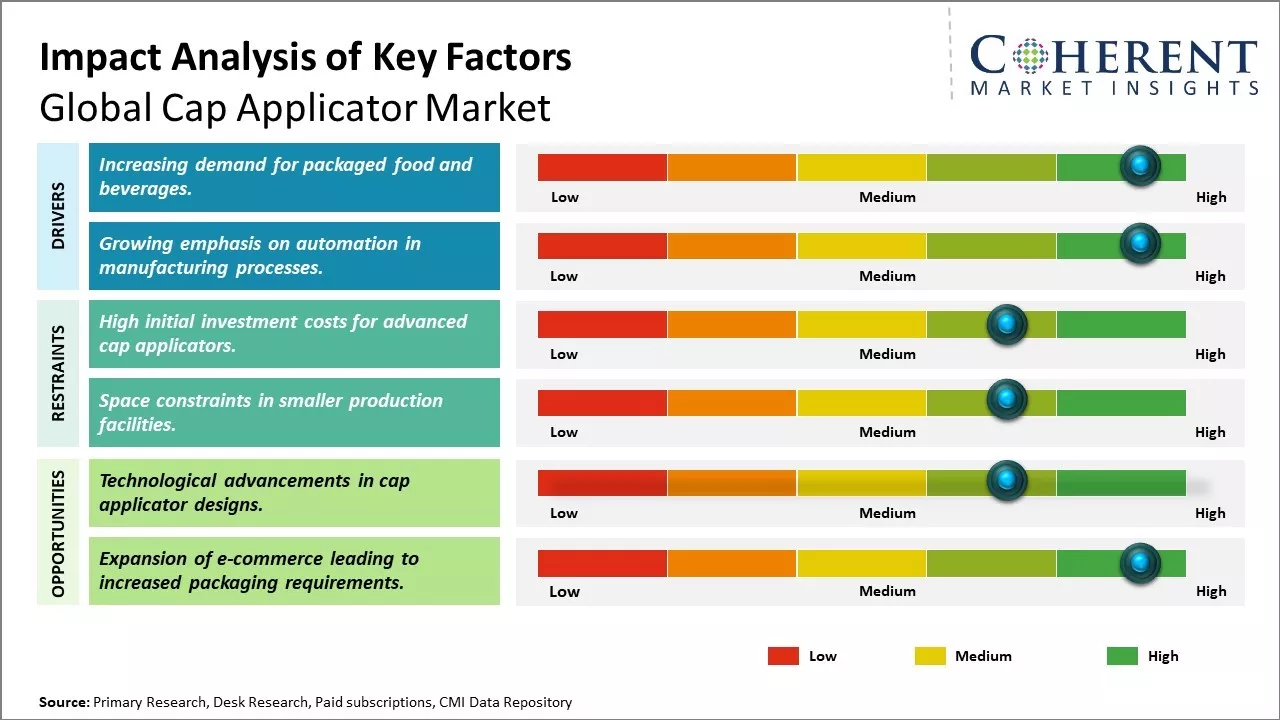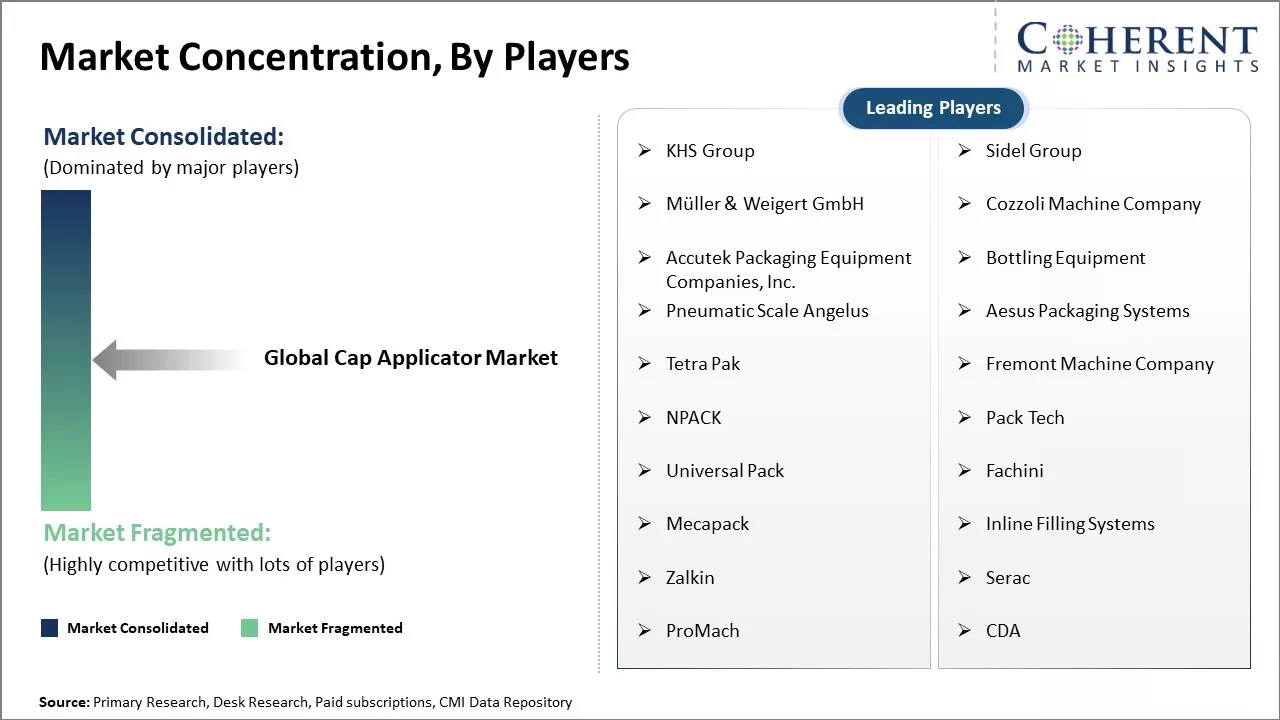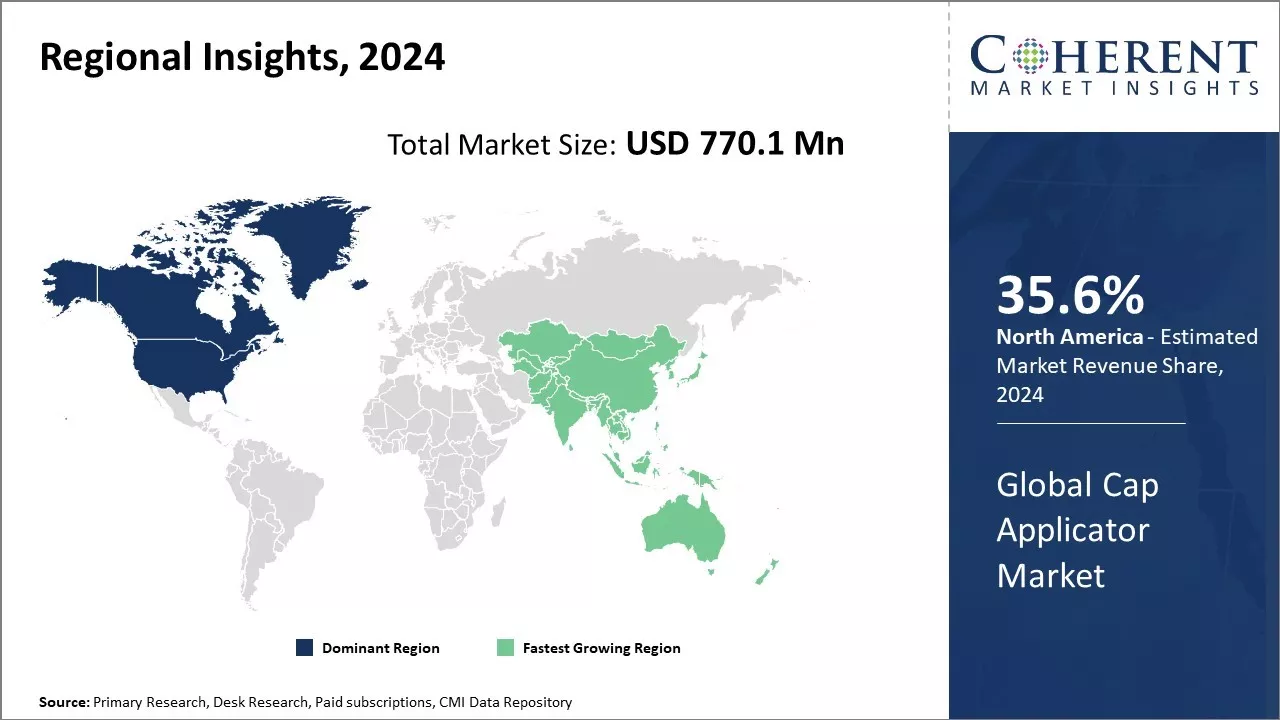Global cap applicator market is estimated to be valued at USD 797.9 Mn in 2025 and is expected to reach USD 1,022.7 Mn by 2032, exhibiting a compound annual growth rate (CAGR) of 3.6% from 2025 to 2032.

Discover market dynamics shaping the industry: Download Free Sample
Cap applicators are specialized machines that are used for applying caps or closures to bottles and packaging in various end-use industries such as pharmaceuticals, personal care, and homecare amid high production volumes. Growing pharmaceutical industry can drive the global cap applicator market growth. For instance, according to the data by Invest India in 2022, the pharmaceutical industry in India is expected to reach US$ 65 Bn by 2025 and to US$ 130 Bn by 2030. Growing emphasis on pharmaceutical production to meet rising healthcare demands along with increasing consumption of bottled beverages globally can boost demand for cap applicators. However, availability of alternative closing solutions may hamper the market growth.
Market Driver - Increasing demand for packaged food and beverages
Packaged food and drink market has witnessed tremendous development in the recent years. With improving discretionary cash flow and expanding introduction to a wide assortment of brands through advanced media, more individuals opt for helpful pre-fixed bundles over customary planning. Retailers are providing a growing range of appealing and affordable packages that attract consumers who desire pre-tested and pre-prepared foods for their consumption. The utilization of bundling in current circumstances provides advantages to both makers and clients. It expands realistic usability and time saving while keeping up newness. Furthermore, bundling permits providers to add esteem through engaging plan and showcasing that pulled in shoppers and upgrades deals.
This burgeoning interest for bundled nourishments and drinks boosts demand for cap applications. manufacturer need robotic accuracy and productivity to meet the interest through consistent creation volumes on their bundling lines. Caps provide the last seal that guarantees scope and newness until the point that the item arrives at the shopper. Precision capping turns into a need to guarantee item value while keeping up high creation rates. Programmed cap application frameworks fit the bill ideal as these can work consistently at high velocities with little blunder rates. Sellers have consequently embraced mechanization to more readily oversee the unpredictability included with bundling an assortment of items while meeting guidelines concerning bundling execution and security. Developing acknowledgment of helpful bundled items can boost utilization of programmed cap application hardware.

Get actionable strategies to beat competition: Download Free Sample
Focus on productivity through automation
In the competitive landscape of product manufacturing, optimizing processes to achieve maximum profitability is essential for businesses. Automation provides opportunities to shift workers to higher-value tasks while delivering greater repeatability and consistency than manual methods can achieve. Various industries have successfully implemented automation solutions to enhance production management, and similar trends are emerging in the packaging sector, where precision and efficiency are critical due to the large volumes involved. Automated cap application systems meet this demand, operating seamlessly without the limitations of human capabilities.
Manufacturers gain numerous advantages from automation. It enables continuous operation since machines do not require breaks like human workers. Automation also eliminates human error, thereby enhancing quality consistency. The system incorporates work instructions for accurate filling and sealing, even under heavy production loads, ensuring zero product loss due to packaging issues. Additionally, automated systems offer operational transparency, as software-based designs can easily manage a variety of product types and packaging formats. Automation improves resource utilization and fosters the manufacturing efficiency necessary to remain competitive. Given these benefits, its adoption is expected to rise as packaging production increasingly moves towards Industry 4.0 and connected automation.
Key Takeaways from Analyst:
Global cap applicator market growth is driven by growing demand for caps and closures from the food and beverage industry that leads to increased need for cap applicators. Availability of alternative packaging solutions such as twist-off bottle caps can hamper the market growth.
North America currently dominates the global cap applicator market, owing to strong demand from leading food and beverage companies based in the region. Europe is also a major market for cap applicators due to a well-established packaging industry. Asia Pacific region presents lucrative opportunities for market expansion due to rising consumption of packaged foods and beverages in populous nations like India and China.
There will be increase in adoption of inline cap applicators as these enable high-speed capping and meet stricter production requirements of manufacturers. Furthermore, multi-head cap applicators that can handle different caps sizes also gain popularity. Development of portable and modular cap applicators could open up opportunities in the contract packing and small-scale industries. Manufacturers are also focusing on innovations in cap application technology such as advanced drive systems for greater efficiency and sensitivity control to handle various bottle shapes and sizes.
Market Challenge - High initial investment costs for advanced cap applicators
Global cap applicator market growth can be hampered due to high initial investment costs for advanced cap applicators. The advanced automated cap applicators which can apply caps at high speeds with precise tolerances are costly machines with price tags running into several million dollars depending on the type and capacity of the machine. This high upfront cost poses significant challenges for manufacturers especially small and medium sized companies to adopt new technologies. The longer return on investment period also discourages replacements or expansion. Initial layout of integration and operational costs also adds to the investment burden. While advanced applicators improve productivity and efficiency, their steep price acts as a deterrent in the initial phases. This challenges faster adoption rates and delays potential gains from automation. Hefty investments required for automated applicators limits their appeal for many market players.
Market Opportunity - Technological advancements in cap applicator designs
Global cap applicator market can witness growth opportunities due to continuous technological advancements. The integration of robotics, AI, IoT, and sensing technologies have enabled the development of next generation smart cap applicators. The new generation machines offer advanced features such as real-time quality monitoring, predictive maintenance, reduced changeover times, and remote operations. Cap applicators integrated with vision inspection systems ensure error-proof capping with zero defect rates. The new designs focus on modularity and flexibility for multi-product changeovers. This aids in reducing setup times and improves production versatility. Self-learning controllers in intelligent applicators also increase efficiencies with optimal process parameters. The emerging technologies are expected to make cap applicators more affordable by reducing costs of operations and maintenance. The innovative automation solutions can boost their increased adoption across various end-use industries like pharmaceuticals, cosmetics, food and beverages.
Insights, By Type: unprecedented efficiency and productivity advantages over manual alternatives of Cap Applicators
In terms of type, automatic cap applicators segment is estimated to contribute the highest market share of 50.2% in 2025, owing to their unprecedented efficiency and productivity advantages over manual alternatives. Automatic cap applicators can apply thousands of caps per hour with unparalleled precision and accuracy due to their advanced mechanical design and quality control systems. This high-speed capping allows producers to maximize output and minimize labor costs associated with manual capping. As the food and beverage industry grapples with rising consumer demand and pressure to reduce prices, automatic machines have become indispensable for maintaining profit margins through boosted line efficiencies. Their set-it-and-forget-it operation also frees human workers to focus on higher-level tasks instead of repetitive motion jobs. As production volumes increase across industries to meet global consumption, automatic applicators are uniquely suited to handle massive throughput without compromising quality- a crucial advantage driving their widespread preference. Several key manufacturers have also focused on innovating even faster and smarter automatic models to consolidate their market leadership. These technological enhancements like integrated vision systems and predictive maintenance functions cement automatic cap applicators' segment.
Insights, By Application: Increasing applications in food and beverage
In terms of application, food and beverage segment is estimated to contribute the highest market share of 39.3% in 2025, owing to its massive worldwide product volumes. As populations and living standards rises globally, consumption of packaged foods and drinks has exploded, necessitating advanced capping solutions to keep pace with surging production schedules. Moreover, food safety regulations have grown ever more stringent, requiring reliable sealing technologies to prevent contamination - a critical quality assured by applicators. Consumers now expect attractive, tamper-proof packaging across popular consumer brands, thus, boosting demand for high-performing cap sealers. Capping of food and drink also involves additional sanitation challenges compared to other industries, favoring easy-to-clean, automated cap applicators. Their quality oversight allows consistency in critical cap torques and seals. Furthermore, leading food and beverage corporations have consolidated market control, enjoying substantial bulk-buying influence. As these megabrands push supplier partnerships to maximize efficiencies globally, cap applicators tailored for their immense volumes dominate procurement spend.

Need a Different Region or Segment? Download Free Sample
North America has established itself as the leading regional market for cap applicator globally with an estimated market share of 36.1% in 2025. The strong pharmaceutical manufacturing base and well-established pharmaceutical industry in the U.S. and Canada have boosted cap applicator demand. Major players such as KHS Group, Sidel Group and other have set up state-of-the-art manufacturing facilities and R&D centers to cater to growing needs of end-use industries.
The presence of international pharmaceutical companies and contract manufacturers in the region ensures a steady demand for different types of cap applicators. Moreover, focus on automation in packaging lines and adoption of advanced technologies drives market growth in North America. Contract filling and packaging services are highly developed to meet strict regulatory requirements, thus, boosting uptake of efficient cap applicators.
Asia Pacific is poised to witness the fastest growth in the cap applicator market over the forecast period. Improving healthcare infrastructure, increasing penetration of health insurance, rising disposable incomes, and growing medical expenditure can boost expansion of the pharmaceutical industry across the region. For instance, according to the data from the Bureau of Economic Analysis in 2025, U.S. disposable personal income was increased by 1% in May 2024, followed by a modest rise of 0.6% in June 2024 compared to the previous months. These incremental gains in disposable personal income reflect ongoing economic trends and consumer behavior, contributing to overall financial stability and spending capacity in the U.S. economy.
Countries like China, India, Japan, and South Korea are witnessing heavy investments by leading pharmaceutical manufacturers to leverage the large consumer base and low-cost manufacturing advantages. Many local manufacturers are entering into technical collaborations and partnerships with global players to localize production and supply cap applicators. Flourishing medical device sector and rising demand for caps and closures present untapped opportunities for cap applicator manufacturers.
Asia Pacific region demonstrates high market potential attributed to rapid industrialization, increasing contractual manufacturing activities, and strides made towards the goal of universal healthcare access. The upcoming trade agreements like RCEP can intensify cross-border trades and imports-exports of packaging machinery and equipment including cap applicators within the region.
Cap Applicator Market Report Coverage
| Report Coverage | Details | ||
|---|---|---|---|
| Base Year: | 2024 | Market Size in 2025: | USD 797.9 Mn |
| Historical Data for: | 2020 To 2024 | Forecast Period: | 2025 To 2032 |
| Forecast Period 2025 to 2032 CAGR: | 3.6% | 2032 Value Projection: | USD 1,022.7 Mn |
| Geographies covered: |
|
||
| Segments covered: |
|
||
| Companies covered: |
KHS Group, Sidel Group, Müller & Weigert GmbH, Cozzoli Machine Company, Accutek Packaging Equipment Companies, Inc., Bottling Equipment, Pneumatic Scale Angelus, Aesus Packaging Systems, Tetra Pak, Fremont Machine Company, NPACK, Pack Tech, Universal Pack, Fachini, Mecapack, Inline Filling Systems, Zalkin, Serac, ProMach, and CDA |
||
| Growth Drivers: |
|
||
| Restraints & Challenges: |
|
||
Uncover macros and micros vetted on 75+ parameters: Get instant access to report
*Definition: Global cap applicator market consists of equipment, tools, and machines used for automatically or semi-automatically placing caps or closures on containers during packaging operations. Cap applicators are commonly used in the food and beverage, personal care and cosmetics, pharmaceuticals, and chemical industries to cap containers like bottles and jars at high speeds. Various types of cap applicators available are snap-on, screw-on, and crimp-on applicators that can cap different types and sizes of containers and caps.
Share
Share
About Author
Kalpesh Gharte is a senior consultant with approximately 5 years of experience in the consulting industry. Kalpesh holds an MBA in Operations and Marketing Management, providing him with a strong foundation in market strategy and analysis. He has contributed to various consulting and syndicated reports, delivering valuable insights that support informed business decisions
Missing comfort of reading report in your local language? Find your preferred language :
Transform your Strategy with Exclusive Trending Reports :
Frequently Asked Questions
Joining thousands of companies around the world committed to making the Excellent Business Solutions.
View All Our Clients